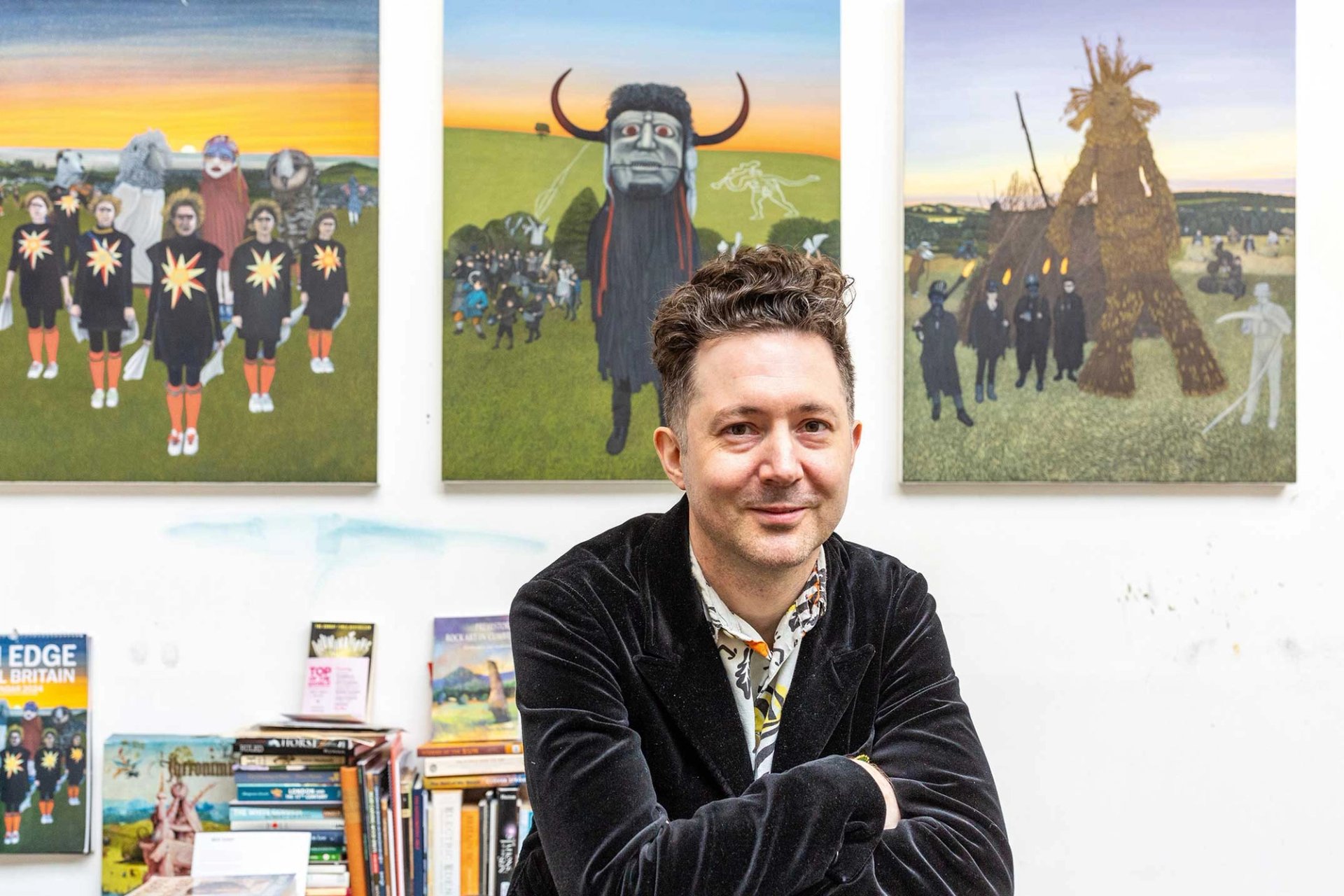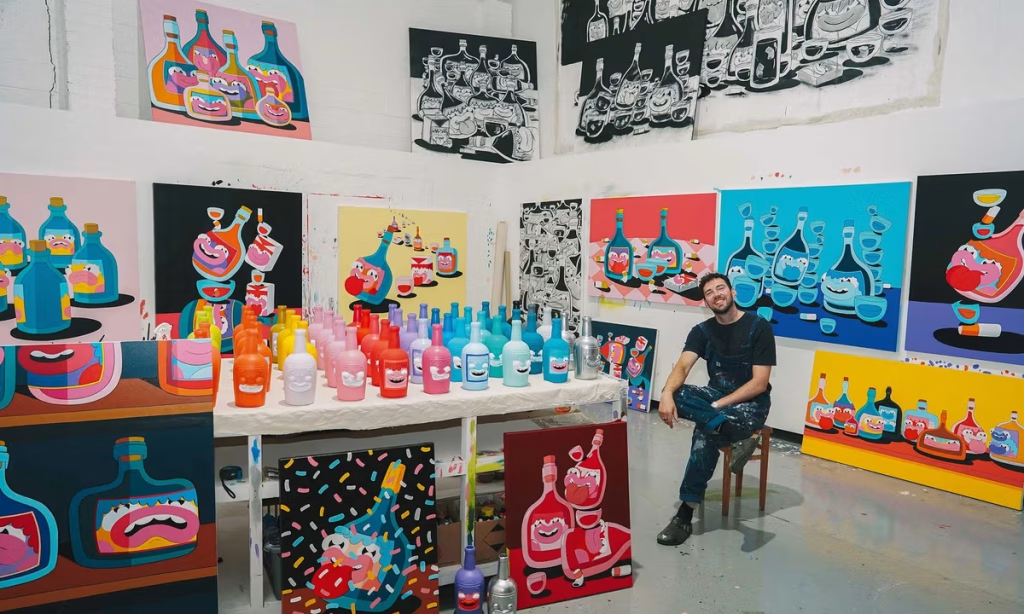Before art dealers entered the scene in the 19th century, artists would mostly sell their work to patrons without the aid of a middleman. Michelangelo spoke to his small but powerful group of patrons directly, while Rembrandt organised his own commissions and sold his art from a “shop” next to his studio. Today, as the art market’s power dynamics continue to evolve, an increasing number of artists are once again taking a more independent approach to the making, marketing and selling of their art.
Damien Hirst famously broke the mould back in 2008 when he sold more than 200 new pieces straight from the studio at Sotheby’s. Bypassing his dealers (and their 50% cut), the auction racked up £111.4m over two days—all while Lehman Brothers went bust. Banksy, too, was an early proponent, setting up Pest Control in 2008 to regain strict ownership of his sales.
More and more artists are becoming disillusioned by the current gallery system
Many blue-chip artists now have complete agency over their brand development. Take Marina Abramović, who often operates outside of the galleries that represent her. During Frieze Week she was showing with Saatchi Yates in a one-off collaboration, while last year she staged a seven-minute intervention on the Pyramid stage at Glastonbury, earning her more visibility than a gallery ever could. Peter Doig, who famously left his dealer Michael Werner after 23 years in 2023, currently has a show at the Serpentine Gallery in London, supported by the fashion brand Phoebe Philo and the Luma Foundation (among others), rather than by the usual brace of galleries.
And it is not just big names who are going it alone. Emerging and mid-tier artists are also choosing to work outside of the traditional channels in greater numbers than ever before. The curator and private dealer Matt Carey-Williams believes the reason the historic relationship between artist and dealer is being questioned today comes down to three things: “competition, control and money”. Emerging artists in particular, Carey-Williams says, want to have the flexibility to move about after graduating so that they can find the best possible partnerships. “Working with independent curators, showing in nomadic or pop-up exhibitions and exhibiting with their peers and friends affords these younger artists the necessary framework to display their practice to a wide audience but without the fear that they have gone to bed too soon with the wrong person,” he adds.
Vashti Cassinelli (left) and Ella Mills have set up a partnership to support women and non-binary artists
Photo: Jassy Earl
Some are choosing to not get into bed with a gallery at all. The Bristol-based artist Matthew Callaby, known as Mr Callaby, says he is “not anti-galleries”; he just has not found one that can add to the service he already provides collectors. Plus, there are opportunities with commercial rents in British city centres. “More and more artists are becoming disillusioned by the current gallery system, and high streets are also crumbling, which means all sorts of interesting spaces are popping up,” he says.
Stripped-back model
Callaby’s is a stripped-back model. Having studied design and worked in advertising for seven years, he saved up and moved to Montenegro during the pandemic to focus on his painting. There, he made enough money selling his work through Instagram that he returned to the UK as a full-time artist. Since then, he has organised and funded two pop-up shows in central London; both sold out (paintings are priced at around £3,000-£4,000 and collectibles around £750). Callaby now sells directly to his client base entirely via Instagram, where he has around 80,000 followers. The pop-ups “create an additional sense of urgency” to purchase his work, he says, noting that exhibition costs never go above around the equivalent of a 35% commission. “So, I’m still making more than if a gallery took a 50% cut,” he points out.
Instagram may have benefited artists in recent years, particularly coming out of the pandemic, but changes to the algorithms, which prioritise filtered, attention-grabbing content over authentic interactions, have increasingly made it hard for artists to make a living. As Callaby says: “Engagement is down. I know a lot of artists that have gone from getting thousands of likes to a couple hundred on a post; it’s making them question whether they can continue being independent.”
Social media’s promise to deliver network, community and democratisation may have fallen foul of late capitalism, but its founding principles are what many artists are striving for today. Expansive networks are also what have enabled older women artists in particular to bypass the traditional art world and sell directly to collectors. According to a report published in April by the journalists Charlotte Burns and Julia Halperin, 55% of female artists said they were selling work independently of galleries and advisers, with women over 65 leading the way in selling art directly; 59% of them having done so in the past five years, compared with 53% of artists under 40.
‘Nimble and responsive’
Vashti Cassinelli and Ella Mills, who both have curatorial practices and are based in Devon, decided to set up Cassinelli Mills earlier this year with a view to supporting women and non-binary artists. Not strictly a gallery, the business promotes artists “beyond the traditional commercial and transactional model”, Cassinelli says. “We are concerned with giving more freedoms and opportunities to artists to network and find relationships with other aligned artists through meetings and mentorships and between early career and established artists.” Nonetheless, commercial sales are a factor. “It’s about finding a model that works financially for everyone but also creating new relationships with artists that feel equitable and come from a place of caring,” Cassinelli adds. The organisation takes a 45% cut on sales, while 5% goes into a pot to support other projects.
Rather than represent artists in the traditional way, Cassinelli Mills works in a “more nimble and responsive way”, Cassinelli says, exhibiting works in their arts space at Southcombe Barn in Dartmoor. “This way, we can work without a two-year wait for artists. We can also do things outside of London with new audiences and create more conversations between rural and urban audiences,” she adds.
It is an approach that works for the Brighton-based artist Arabel Lebrusan, who this summer launched a crowdfunding campaign to support her installation of more than 100 swallows with engraved tin beaks at Southcombe Barn. “I’m a multidisciplinary artist; my work doesn’t always sit politely on a wall or shelf. Sometimes it inhabits a building, a garden like at Southcombe Barn, or even someone’s body in the form of a ring made from police-confiscated knives,” Lebrusan says. Her jewellery practice helps sustain her artistic practice.
The London-based artist Ben Edge, who has self-funded his exhibitions for the past ten years, also prefers unusual spaces to exhibit. In November, he opens a show in the Fitzrovia Chapel, where he will present a body of work titled Children of Albion, including his largest-ever painting with the same title. The series examines British folk customs, from prehistory to contemporary times. “I like going to galleries, but I had this realisation one day that no gallery is going to come along and wave a magic wand and make me a rich and successful artist,” Edge says. “I saw a lot of people scrapping for crumbs off this so-called art-world cake, so I decided it’s time to bake my own cake.”
Today, Edge makes 40% of his income from merchandise; the Fitzrovia Chapel show alone has been funded by a calendar he produces annually. The rest of his income comes from the sales of paintings.
Challenging power structures
Of course, galleries can be invaluable in providing serious, professional structure for artists in the art world—not to mention a nurturing environment, an understanding of art history, marketing clout and long-established links with museums and private collectors. But, as the fine-art world bleeds ever deeper into luxury retail, fashion, TV, film, music and even sports, there is undoubtedly a sense that the traditional power structures are being challenged.

Ben Edge has funded his show through merchandise sales
Sylvie Tata Photography
Many in the art world, even dealers, see this as a positive thing. Carey-Williams says he developed his business with a “focus on presentations, not representation”. He adds: “I want to be nimble and flexible enough to work with a wider net of artists.” All of this is facilitated by open, honest communication—and, crucially, camaraderie. As Carey-Williams puts it: “Keeping expectations manageable and deliverable. Not biting off more than I can chew. The stuff of mates, pints and smiles.”
His strategy is working. The dealer says he has “zero interest” in encroaching on someone else’s representation of an artist. “I want to be a part of their world instead of disturbing it,” Carey-Williams says, adding: “The artists enjoy the extra exposure; their galleries enjoy the fact they’re getting more exposure, and I love working with both on my presentation. When done right, it’s a win-win-win for everyone concerned.”
